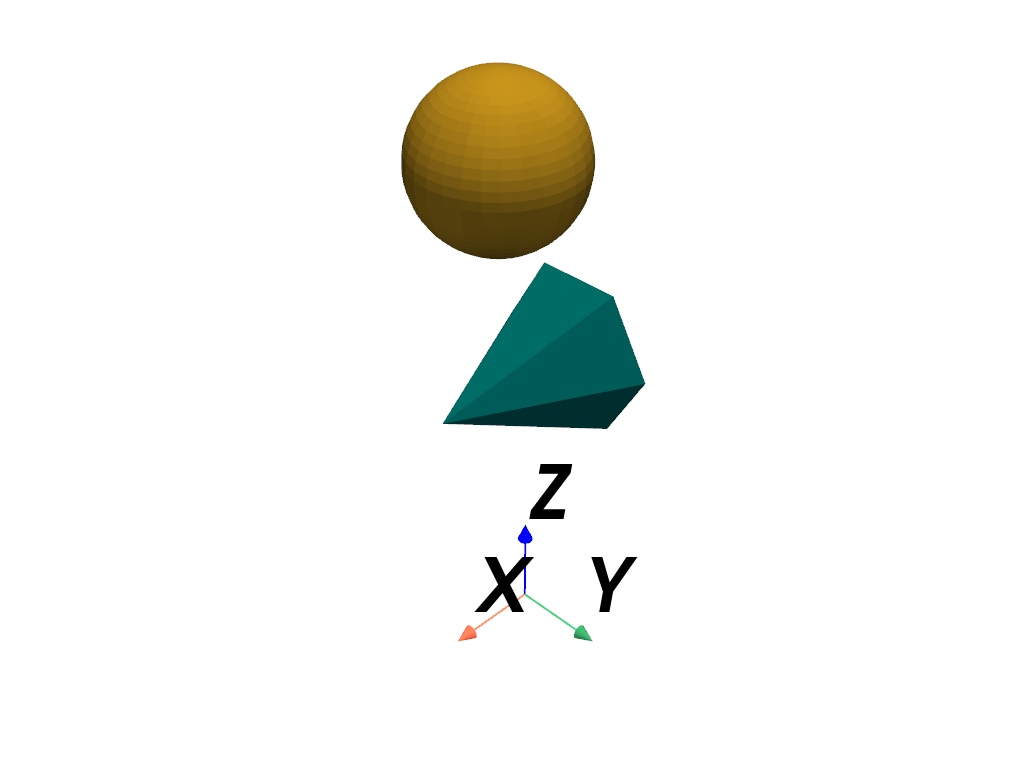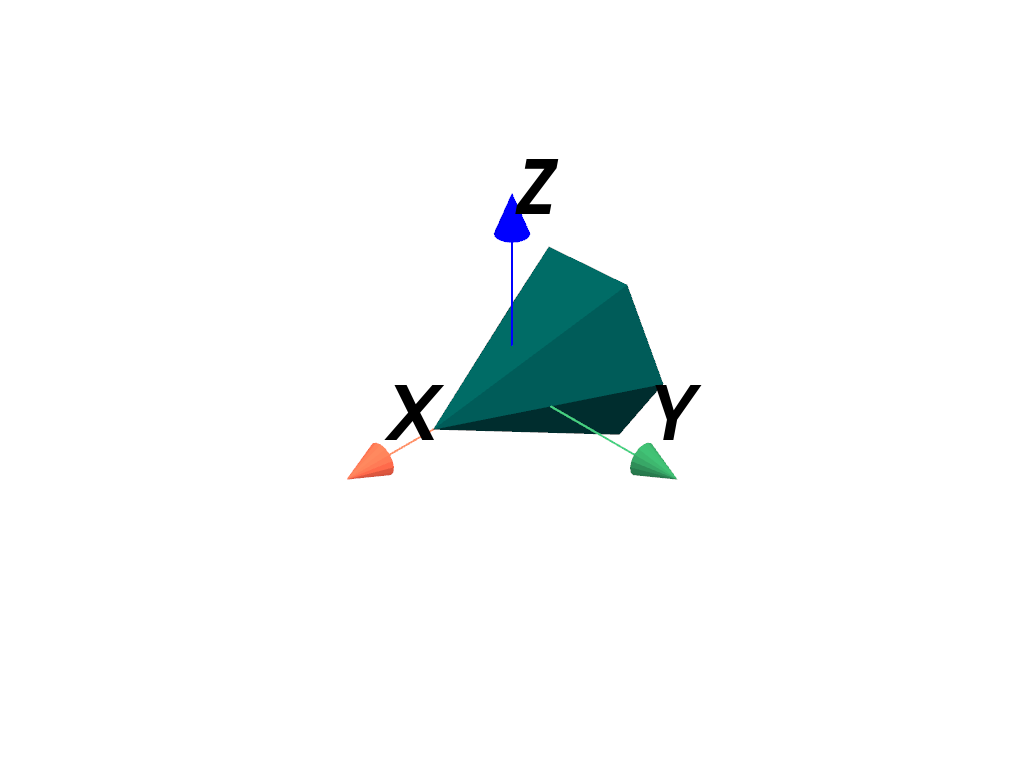pyvista.Transform#
- class Transform(*args, **kwargs)[source]#
Describes linear transformations via a 4x4 matrix.
A
Transformcan be used to describe the full range of linear (also known as affine) coordinate transformations in three dimensions, which are internally represented as a 4x4 homogeneous transformation matrix.The transformation methods (e.g.
translate(),rotate(),compose()) can operate in eitherpre_multiply()orpost_multiply()mode. In pre-multiply mode, any additional transformations will occur before any transformations represented by the currentmatrix. In post-multiply mode (the default), the additional transformation will occur after any transformations represented by the current matrix.Note
This class performs all of its operations in a right-handed coordinate system with right-handed rotations. Some other graphics libraries use left-handed coordinate systems and rotations.
Added in version 0.45.
- Parameters:
- trans
TransformLike|Sequence[TransformLike],optional Initialize the transform with a transformation or sequence of transformations. By default, the transform is initialized as the identity matrix.
- point
VectorLike[float],optional Point to use when composing some transformations such as scale, rotation, etc. If set, two additional transformations are composed and added to the
matrix_list:translate()topointbefore the transformationtranslate()away frompointafter the transformation
By default, this value is
None, which means that the scale, rotation, etc. transformations are performed about the origin(0, 0, 0).- multiply_mode‘pre’ | ‘post’,
optional Multiplication mode to use when composing. Set this to
'pre'for pre-multiplication or'post'for post-multiplication.
- trans
See also
pyvista.DataObjectFilters.transformApply a transformation to a mesh.
pyvista.Prop3D.transformTransform an actor.
Examples
Create a transformation and use
+to compose a translation.>>> import numpy as np >>> import pyvista as pv >>> position = (-0.6, -0.8, 2.1) >>> translation_T = pv.Transform() + position >>> translation_T.matrix array([[ 1. , 0. , 0. , -0.6], [ 0. , 1. , 0. , -0.8], [ 0. , 0. , 1. , 2.1], [ 0. , 0. , 0. , 1. ]])
Using
+performs the same concatenation as callingtranslate().>>> np.array_equal( ... translation_T.matrix, pv.Transform().translate(position).matrix ... ) True
Create a transformation and use
*to compose a scaling matrix.>>> scale_factor = 2.0 >>> scaling_T = pv.Transform() * scale_factor >>> scaling_T.matrix array([[2., 0., 0., 0.], [0., 2., 0., 0.], [0., 0., 2., 0.], [0., 0., 0., 1.]])
Using
*performs the same concatenation as callingscale().>>> np.array_equal(scaling_T.matrix, pv.Transform().scale(scale_factor).matrix) True
Compose the two transformations using
*. This will compose with post-multiplication such that the transformations are applied in order from left to right, i.e. translate first, then scale.>>> transform_post = translation_T * scaling_T >>> transform_post.matrix array([[ 2. , 0. , 0. , -1.2], [ 0. , 2. , 0. , -1.6], [ 0. , 0. , 2. , 4.2], [ 0. , 0. , 0. , 1. ]])
Post-multiplication is equivalent to using matrix multiplication on the arrays directly but with the arguments reversed:
>>> mat_mul = scaling_T.matrix @ translation_T.matrix >>> np.array_equal(transform_post.matrix, mat_mul) True
Alternatively, compose the transformations by chaining the methods with a single
Transforminstance. Note that post-multiply is used by default.>>> transform_post = pv.Transform() >>> transform_post.multiply_mode 'post' >>> _ = transform_post.translate(position).scale(scale_factor) >>> transform_post.matrix array([[ 2. , 0. , 0. , -1.2], [ 0. , 2. , 0. , -1.6], [ 0. , 0. , 2. , 4.2], [ 0. , 0. , 0. , 1. ]])
Use
n_transformationsto check that there are two transformations.>>> transform_post.n_transformations 2
Use
matrix_listto get a list of the transformations. Since post-multiplication is used, the translation matrix is first in the list since it was applied first, and the scale matrix is second.>>> transform_post.matrix_list[0] # translation array([[ 1. , 0. , 0. , -0.6], [ 0. , 1. , 0. , -0.8], [ 0. , 0. , 1. , 2.1], [ 0. , 0. , 0. , 1. ]])
>>> transform_post.matrix_list[1] # scaling array([[2., 0., 0., 0.], [0., 2., 0., 0.], [0., 0., 2., 0.], [0., 0., 0., 1.]])
Create a similar transform but use pre-multiplication this time. Compose the transformations in the same order as before using
translate()andscale().>>> transform_pre = pv.Transform().pre_multiply() >>> _ = transform_pre.translate(position).scale(scale_factor)
This is equivalent to using matrix multiplication directly on the arrays:
>>> mat_mul = translation_T.matrix @ scaling_T.matrix >>> np.array_equal(transform_pre.matrix, mat_mul) True
Show the matrix list again. Note how the order with pre-multiplication is the reverse of post-multiplication.
>>> transform_pre.matrix_list[0] # scaling array([[2., 0., 0., 0.], [0., 2., 0., 0.], [0., 0., 2., 0.], [0., 0., 0., 1.]])
>>> transform_pre.matrix_list[1] # translation array([[ 1. , 0. , 0. , -0.6], [ 0. , 1. , 0. , -0.8], [ 0. , 0. , 1. , 2.1], [ 0. , 0. , 0. , 1. ]])
Apply the two post- and pre-multiplied transformations to a dataset and plot them. Note how the meshes have different positions since post- and pre-multiplication produce different transformations.
>>> mesh_post = pv.Sphere().transform(transform_post, inplace=False) >>> mesh_pre = pv.Cone().transform(transform_pre, inplace=False) >>> pl = pv.Plotter() >>> _ = pl.add_mesh(mesh_post, color='goldenrod') >>> _ = pl.add_mesh(mesh_pre, color='teal') >>> _ = pl.add_axes_at_origin() >>> pl.show()

Get the composed inverse transformation matrix of the pre-multiplication case.
>>> inverse_matrix = transform_pre.inverse_matrix >>> inverse_matrix array([[ 0.5 , 0. , 0. , 0.3 ], [ 0. , 0.5 , 0. , 0.4 ], [ 0. , 0. , 0.5 , -1.05], [ 0. , 0. , 0. , 1. ]])
Similar to using
matrix_list, we can inspect the individual transformation inverses withinverse_matrix_list.>>> transform_pre.inverse_matrix_list[0] # inverse scaling array([[0.5, 0. , 0. , 0. ], [0. , 0.5, 0. , 0. ], [0. , 0. , 0.5, 0. ], [0. , 0. , 0. , 1. ]])
>>> transform_pre.inverse_matrix_list[1] # inverse translation array([[ 1. , 0. , 0. , 0.6], [ 0. , 1. , 0. , 0.8], [ 0. , 0. , 1. , -2.1], [ 0. , 0. , 0. , 1. ]])
Transform the mesh by its inverse to restore it to its original un-scaled state and positioning at the origin.
>>> mesh_pre_inverted = mesh_pre.transform(inverse_matrix, inplace=False) >>> pl = pv.Plotter() >>> _ = pl.add_mesh(mesh_pre_inverted, color='teal') >>> _ = pl.add_axes_at_origin() >>> pl.show()

Methods
Transform.apply(obj, /[, mode, inverse, copy])Apply the current transformation
matrixto points, vectors, a dataset, or actor.Transform.apply_to_actor(actor, /[, mode, ...])Apply the current transformation
matrixto an actor.Transform.apply_to_dataset(dataset, /[, ...])Apply the current transformation
matrixto a dataset.Transform.apply_to_points(points, /, *[, ...])Apply the current transformation
matrixto a point or points.Transform.apply_to_vectors(vectors, /, *[, ...])Apply the current transformation
matrixto a vector or vectors.Transform.as_rotation([representation])Return the rotation component as a SciPy
Rotationor any of its representations.Transform.compose(transform, *[, multiply_mode])Compose a transformation matrix.
Return a deep copy of the transform.
Transform.decompose(*[, homogeneous])Decompose the current transformation into its components.
Transform.flip_x(*[, point, multiply_mode])Compose a reflection about the x-axis.
Transform.flip_y(*[, point, multiply_mode])Compose a reflection about the y-axis.
Transform.flip_z(*[, point, multiply_mode])Compose a reflection about the z-axis.
Set the transformation to the identity transformation.
Invert the current transformation.
Set the multiplication mode to post-multiply.
Set the multiplication mode to pre-multiply.
Transform.reflect(*normal[, point, ...])Compose a reflection matrix.
Transform.rotate(rotation, *[, point, ...])Compose a rotation matrix.
Transform.rotate_vector(vector, angle, *[, ...])Compose a rotation about a vector.
Transform.rotate_x(angle, *[, point, ...])Compose a rotation about the x-axis.
Transform.rotate_y(angle, *[, point, ...])Compose a rotation about the y-axis.
Transform.rotate_z(angle, *[, point, ...])Compose a rotation about the z-axis.
Transform.scale(*factor[, point, multiply_mode])Compose a scale matrix.
Transform.translate(*vector[, multiply_mode])Compose a translation matrix.
Attributes
Check that the
matrixandinverse_matrixhave finite values.Return the inverse of the current transformation
matrix.Return a list of all inverse transformations applied by this
Transform.Get the inverse flag of the transformation.
Return or set the current transformation matrix.
Return a list of all current transformation matrices.
Set or get the multiplication mode.
Return the current number of composed transformations.
Point to use when composing some transformations such as scale, rotation, etc.